| Vintage Pulp | Dec 9 2010 |

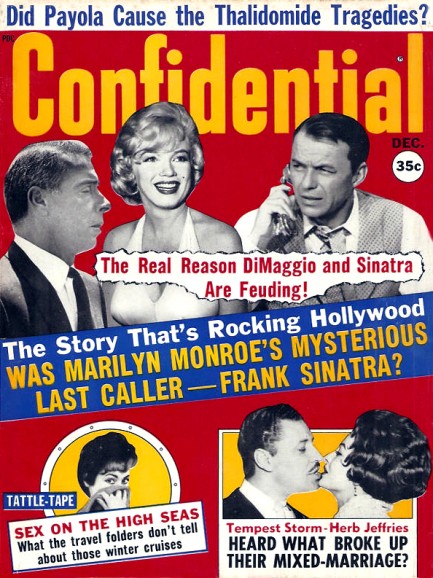
This Confidential from December 1963 offers up several great stories, including an item on a supposed feud between Joe DiMaggio and Frank Sinatra over Marilyn Monroe, who had died the previous year. Confidential contends that DiMaggio considered Sinatra to be part of a too-fast crowd from which Monroe had picked up numerous bad habits that eventually contributed to her death. DiMaggio also supposedly hated Sinatra because Monroe had moved into Sinatra’s Las Vegas house after her marriage to DiMaggio fell apart in 1954. According to most biographers, Monroe and Sinatra became sexually involved around then. The most repeated story concerning the actual genesis of the affair has Sinatra waking one morning and entering his kitchen to find a nude Monroe peering into his refrigerator. According to the story she turned, startled, and said, “Oh Frankie, I didn’t know you got up so early.” From that point forward he was getting up pretty much constantly. Is this tale true? We don’t know, nor does anybody else, probably. But we want to believe.
| Hollywoodland | Jul 7 2010 |

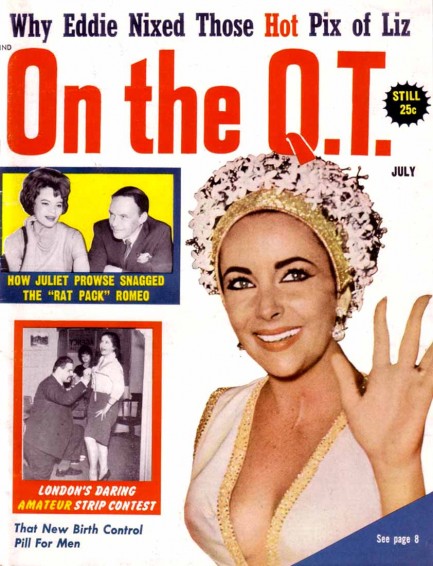
Above is an On the Q.T. from July 1962 with cover stars Elizabeth Taylor, Juliet Prowse and Frank Sinatra. Sinatra was about to marry Prowse, a South African dancer and actress who he had met while both were filming the musical Can-Can. There was just one snag, though—Sinatra didn’t want Prowse to work once they were wed. Asked about the subject, Prowse, pictured below, said that if Sinatra asked her to quit dancing she “would probably yield.” But she didn’t, and the marriage never happened. But what interests us more about this cover is the shot of Liz Taylor and her tracheotomy scar. During the filming of Cleopatra in 1961 she picked up a case of double pneumonia and a surgeon saved her life by inserting a breathing tube through an incision into her windpipe. Taylor’s physical ailments were already the stuff of legend by that point, but her troubles hadn’t even reached their peak yet—to date she has had more than one hundred surgeries.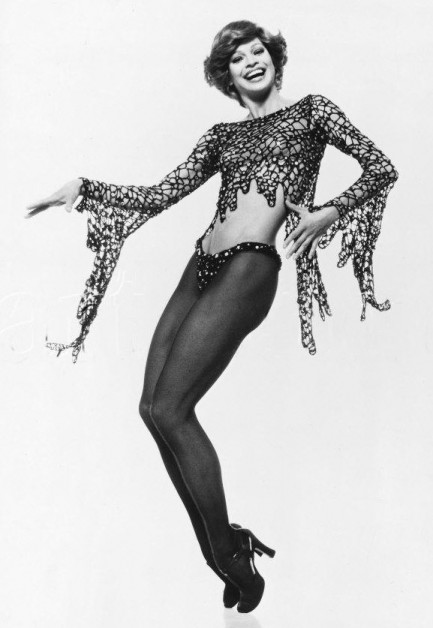
| Hollywoodland | Jun 26 2010 |

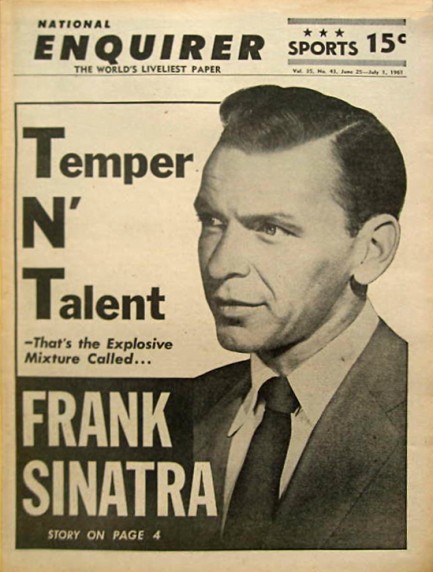
National Enquirer published this week in 1964, with a story about Frank Sinatra and his anger issues. The Enquirer, in detailing instances when Sinatra lost his temper, had numerous examples from which to choose—he once beat Frederick Weisman with a telephone, dumped hot coffee on a casino manager, and shoved a woman through a plate glass window. Except for getting his front teeth knocked out on one occasion, Sinatra suffered no consequences from his behavior—he was simply too powerful, and nobody wanted to get on his bad side. Generoso Pope, Jr., who owned the Enquirer, was an exception. Sinatra hated the Enquirer, of course, and eventually sued it for libel. But that would be years later. The tales the paper published in this particular issue were all true.
| Intl. Notebook | May 4 2010 |


We found some photos of Los Angeles scattered around, including many on an architecture forum called skyscraperpage.com, and thought we’d repost a few. Frank Sinatra once sang that L.A. was his lady. We used to live there and we can tell you she’s no lady. Quite the opposite, in fact—she’s the cruel high mistress of noir. The shots below, all circa 1930s through 1950s, depict L.A. at both her most beautiful and deadly.

















| Intl. Notebook | Musiquarium | Apr 7 2010 |

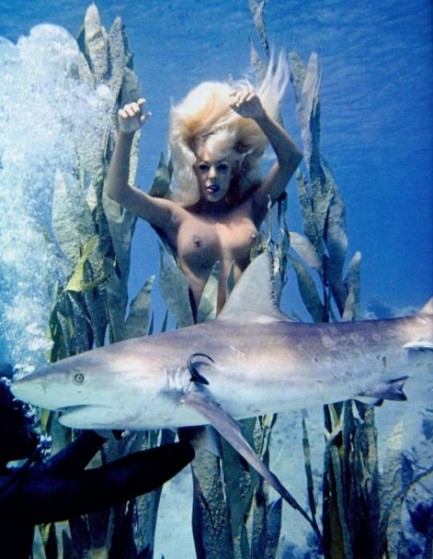
Here’s something that immediately caught our eye—a rare film still of Christine Todd as the titular corpse from 1968’s Lady in Cement. Todd’s appearance is during the film’s first few minutes, as Sinatra’s detective character Tony Rome is scuba diving off the coast of Florida and finds her anchored in a block of cement. We've only seen the movie on network television, and Todd’s nude state was merely implied, which is why finding this unobstructed view was such a surprise. We guess the theatrical version was more revealing. We have a similar shot from a Japanese soundtrack sleeve, below, with a different superimposed shark. As memorable as Ms. Todd was in her debut, it was, sadly, her only movie role. 
| Intl. Notebook | Mar 31 2010 |


Frank Sinatra made a lot of nightspots famous. His mere presence—along with that of his Rat Pack—sprinkled gold dust on bars and eateries from end to end of the U.S., bestowing places such as 21, Toots Shor’s, and Chasen’s with fame that lasted long after the Rat Pack had died. That fame helped many of those old haunts survive into the new millennium, but now one of the most magical Rat Pack hangouts—the Cal Neva Lodge in Lake Tahoe, Nevada—is on the endangered list as it closes its gaming rooms today due to low profitability.
Sinatra owned the Cal-Neva between 1960 and 1963, his star power drawing Hollywood’s top celebrities, along with mob figures who he reportedly shuttled back and 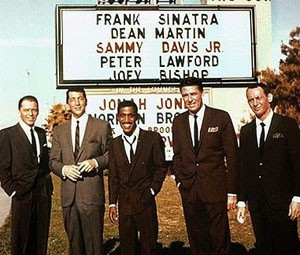 forth to various points around the property via old bootlegging tunnels. He made the Cal-Neva Lodge the jewel of Lake Tahoe, a piece of Tinseltown in what was little more than an alpine village.
forth to various points around the property via old bootlegging tunnels. He made the Cal-Neva Lodge the jewel of Lake Tahoe, a piece of Tinseltown in what was little more than an alpine village.
But the Cal-Neva’s fortunes have been in decline for decades due to the proliferation of nearby Indian casinos, and the general dominance of Las Vegas. When the recent recession hit, the current owners—who had laid off about a hundred employees since 2006—finally decided they could not keep their gaming rooms in operation. Officially, at least, today’s closure is temporary, but industry insiders note that Rat Pack chic is not enough to draw modern gamblers to an older casino like the Cal-Neva Lodge. If so, it’s quite possible that not only will the gaming rooms never reopen, but that the entire Lodge has begun its final decline.
| Hollywoodland | Feb 18 2010 |

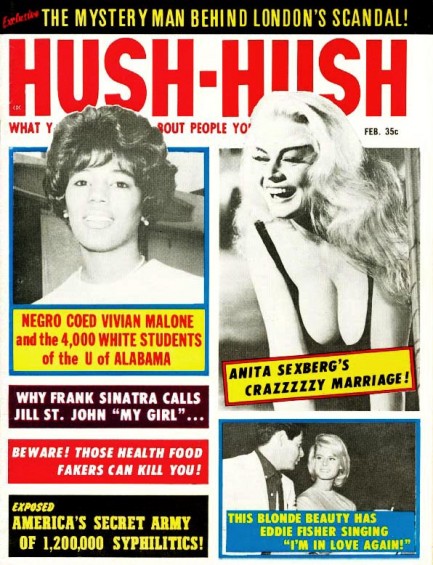
February 1964 Hush-Hush with Anita Ekberg and Vivian Malone. Malone was the woman who Alabama Governor George Wallace barred from entering the University of Alabama during the fall of 1963 after the U.S. Supreme Court ruled segregation unconstitutional. Wallace had state troopers at his back that morning, but when John F. Kennedy nationalized the Alabama National Guard later that day, they escorted Malone to school and the troopers were forced to step aside. Thanks to the court ruling, and Kennedy’s executive order, Malone earned a degree and worked in the U.S. State Department for thirty-one years.
Interestingly, her brother-in-law is the current U.S. Attorney General, Eric Holder. The cover blurb on Malone reads vaguely sexual, but of course the story has nothing to do with that. The Ekberg story is similarly smoke sans fire. You also get a feature on Frank Sinatra and Jill St. John. The two worked together in Come Blow Your Horn in 1963 and Tony Rome in 1967, but most sources say their brief involvement didn’t commence until 1971. However St. John was part of Sinatra’s “in-crowd” for years, and to be seen palling around with Frank was to be accused of waking up in his bed.
Every actress in Hollywood knew that, and few seemed terribly concerned. Finally, after making readers think about sex for most of the issue, Hush-Hush makes them afraid to do it themselves with a story on America’s syphilis epidemic. The mid-century tabs were very much like slasher movies in that way—in the end, sex must always be punished. We found a nice shot on Ebay of Sinatra and St. John together on the set of Tony Rome, and we've posted it below. Our next trick will be to try and find a tabloid that doesn't have Sinatra inside. We think we have our work cut out for us.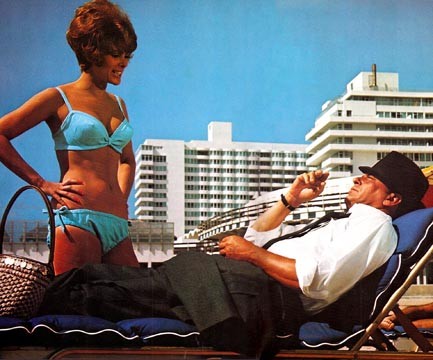
| Sportswire | Dec 8 2009 |

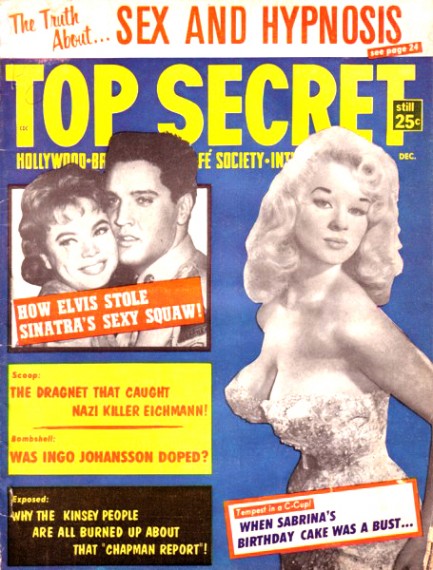
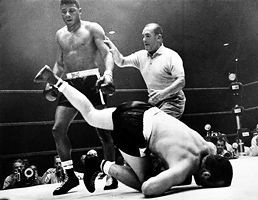 Anyway, the bit that really caught our attention was not the alleged Elvis-Carmen-Sinatra triangle, but the story about Ingo Johansson being doped. Ingemar “Ingo” Johansson was a world champion boxer who had won the heavyweight crown from Floyd Patterson a year earlier. In the March 1960 rematch, Patterson put Johansson’s lights out with a blow so vicious that Johansson was left twitching on the canvas. It was a definitive victory, just as Johansson’s earlier win over Patterson had been, but in 1960 white-black boxing matches were overtly racially divisive, and so Top Secret took advantage by suggesting that perhaps Patterson’s camp managed to slip the Swede a mickey. That question was answered in the March 1961 third match between the two, when Patterson again knocked Johansson out.
Anyway, the bit that really caught our attention was not the alleged Elvis-Carmen-Sinatra triangle, but the story about Ingo Johansson being doped. Ingemar “Ingo” Johansson was a world champion boxer who had won the heavyweight crown from Floyd Patterson a year earlier. In the March 1960 rematch, Patterson put Johansson’s lights out with a blow so vicious that Johansson was left twitching on the canvas. It was a definitive victory, just as Johansson’s earlier win over Patterson had been, but in 1960 white-black boxing matches were overtly racially divisive, and so Top Secret took advantage by suggesting that perhaps Patterson’s camp managed to slip the Swede a mickey. That question was answered in the March 1961 third match between the two, when Patterson again knocked Johansson out.After their careers were over, Johansson and Patterson became good friends and even flew to visit each other in their native countries every year. Top Secret could well have done a story on that, but of course harmony doesn’t sell magazines. So while in the U.S. civil rights strife raged through the rest of the sixties and into the seventies, two guys who once made a living beating the living shit out of each other quietly proved that, given a chance to see each other’s similarities rather than differences, people tend to get along just fine.
| Hollywoodland | Nov 23 2009 |

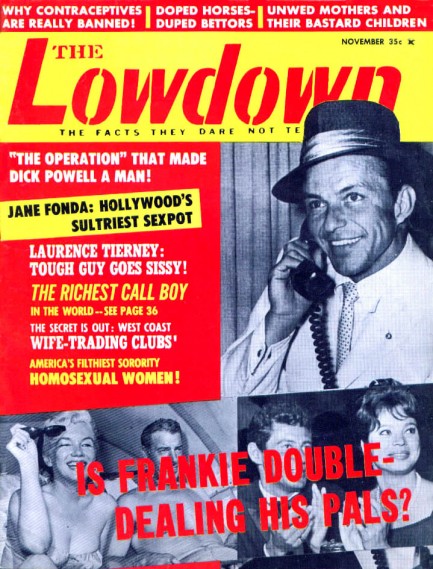
The publishers of The Lowdown went for titillation overload on this screamingly bright November 1961 cover, managing to hit several of the hot button issues of the day, from birth control to lesbianism. Frank Sinatra gets the star treatment here, and The Lowdown actually gets one right—Sinatra and Marilyn Monroe (bottom left) were involved in 1961, around the same time her ex-husband Joe DiMaggio (second from left) was growing concerned about the people around her and asked her to remarry him in hopes of stabilizing her life. Was Sinatra one of the people DiMaggio distrusted? Perhaps, but Monroe said no to Joe's proposal and was dead the next year.
As for Sinatra and Brigitte Bardot (bottom right), we can’t find any references to the two being involved, but they did meet during 1959 to discuss co-starring in a film to be helmed by Bardot’s ex-husband Roger Vadim (second from right). After the three of them talked about the project for a couple of days the idea fell through because Bardot didn’t want to work in Hollywood and Sinatra didn’t want to work in Paris. Did Sinatra and Bardot manage to sneak off for some international relations? We tend to doubt it—in addition to traveling with her ex-husband Vadim (who surely would have frowned on her cheating), she was married to actor/producer Jacques Charrier. Still, you can’t really put anything past Sinatra. But short of reading every Hollywood tell-all ever published, we just can’t say whether he and Bardot got together. The Lowdown hints yes, but take it for what it’s worth.
| Hollywoodland | Jul 30 2009 |

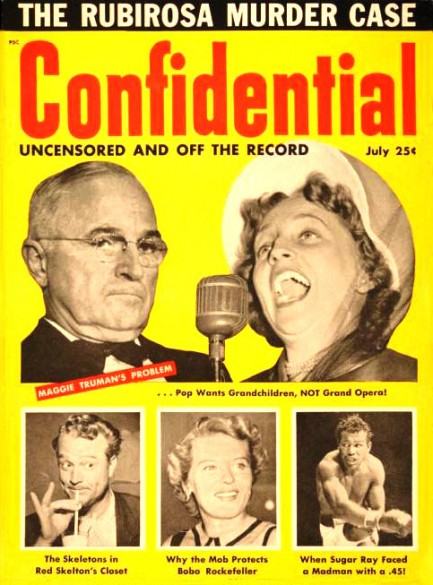 Today we’re back to the top dog of classic tabloids, the always-titillating Confidential. The above issue is from fifty-five years ago this month, July 1954, and as always the cover promises scandalous inside scoop—this time on champs, presidents, and filthy rich heiresses. But it’s the unassuming banner on the Rubirosa murder case that interests us, because it refers to none other than Porfirio Rubirosa, and if you’ve never heard of him, then prepare yourself to meet (cue grandiose flamenco chords) The Most Interesting Man in the World.
Today we’re back to the top dog of classic tabloids, the always-titillating Confidential. The above issue is from fifty-five years ago this month, July 1954, and as always the cover promises scandalous inside scoop—this time on champs, presidents, and filthy rich heiresses. But it’s the unassuming banner on the Rubirosa murder case that interests us, because it refers to none other than Porfirio Rubirosa, and if you’ve never heard of him, then prepare yourself to meet (cue grandiose flamenco chords) The Most Interesting Man in the World. Rubirosa had developed passions for polo, racing, gambling, and other expensive upper crust pursuits. He excelled at all of them. Perhaps the only thing he wasn’t good at was fidelity, which led to his divorce from Flor in 1937. But his sheer magnetism—or perhaps the fact that he was a valuable hired gun—kept him in dictator dad’s good graces, and he continued to receive diplomatic posts. When World War II swept across Europe, Rubirosa made a stack of money selling Dominican exit visas to fleeing Jews. At some point the Gestapo imprisoned him, but he was released after six months. After that, he was allegedly recruited as a political assassin.
Rubirosa had developed passions for polo, racing, gambling, and other expensive upper crust pursuits. He excelled at all of them. Perhaps the only thing he wasn’t good at was fidelity, which led to his divorce from Flor in 1937. But his sheer magnetism—or perhaps the fact that he was a valuable hired gun—kept him in dictator dad’s good graces, and he continued to receive diplomatic posts. When World War II swept across Europe, Rubirosa made a stack of money selling Dominican exit visas to fleeing Jews. At some point the Gestapo imprisoned him, but he was released after six months. After that, he was allegedly recruited as a political assassin.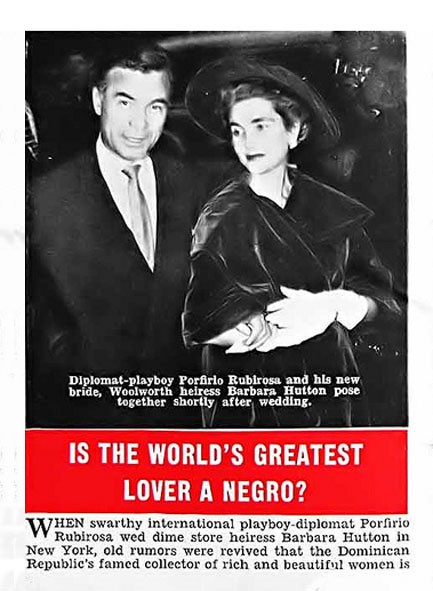
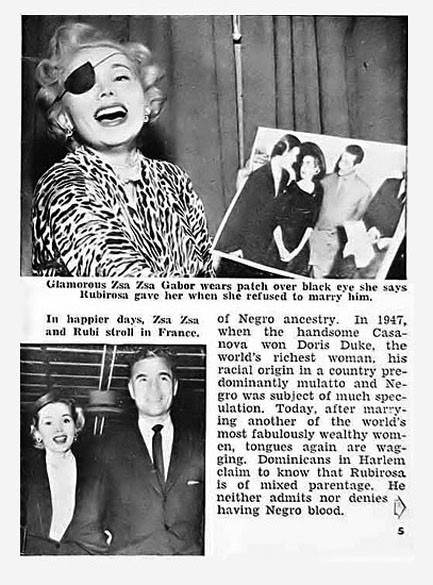 you'd expect from The Most Interesting Man in the World—he never addressed it all, at least not in public. His silence basically amounted to: “So what if I am?” And if the rumors bothered him, he surely derived ample compensation from the fact that legions of female admirers who’d heard about that pepper grinder of his didn’t care.
you'd expect from The Most Interesting Man in the World—he never addressed it all, at least not in public. His silence basically amounted to: “So what if I am?” And if the rumors bothered him, he surely derived ample compensation from the fact that legions of female admirers who’d heard about that pepper grinder of his didn’t care. job?” Rubirosa reportedly answered, “Women are my full-time job.” At some point he met Ian Fleming, and the novice writer came up with the great idea of basing a character on Rubirosa—a certain spy named James Bond.
job?” Rubirosa reportedly answered, “Women are my full-time job.” At some point he met Ian Fleming, and the novice writer came up with the great idea of basing a character on Rubirosa—a certain spy named James Bond.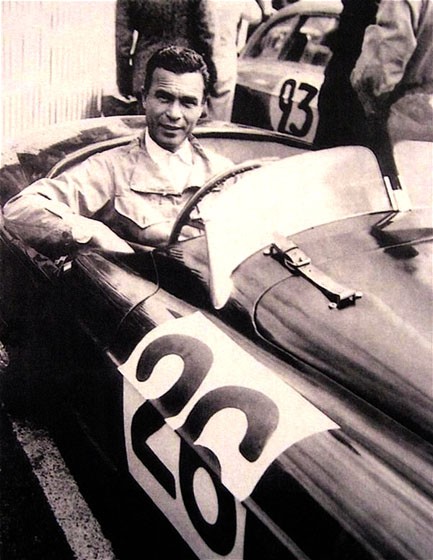 wet, and he was a little drunk. He lost control of the car and died in a fiery crash. The Most Interesting Man in the World was gone—literally burning out rather than fading away. He never finished his memoirs, and today the closest the world has to a Porfirio Rubirosa is a fictional character in a Dos Equis commercial.
wet, and he was a little drunk. He lost control of the car and died in a fiery crash. The Most Interesting Man in the World was gone—literally burning out rather than fading away. He never finished his memoirs, and today the closest the world has to a Porfirio Rubirosa is a fictional character in a Dos Equis commercial. |
 |




































































